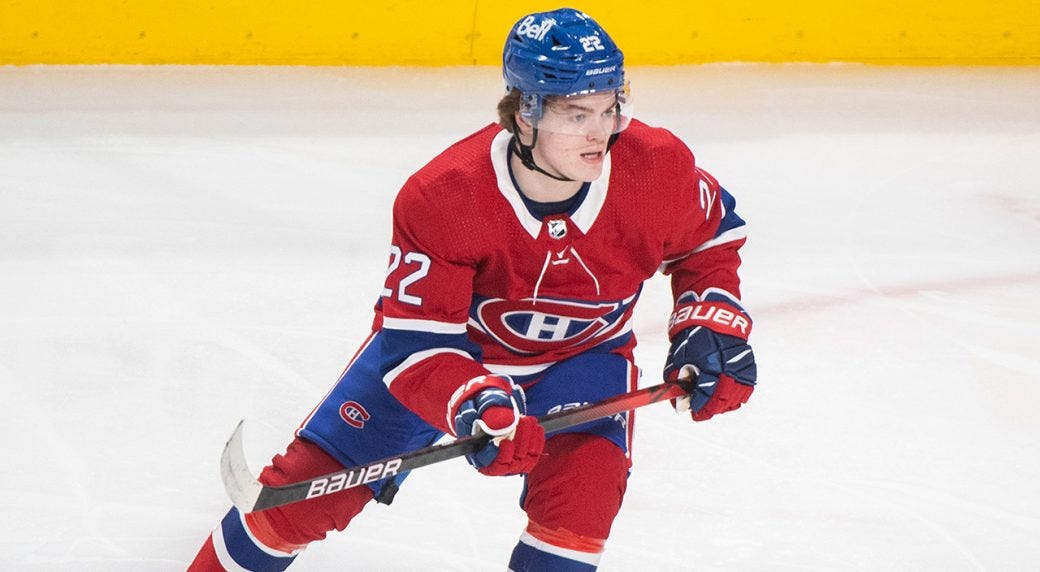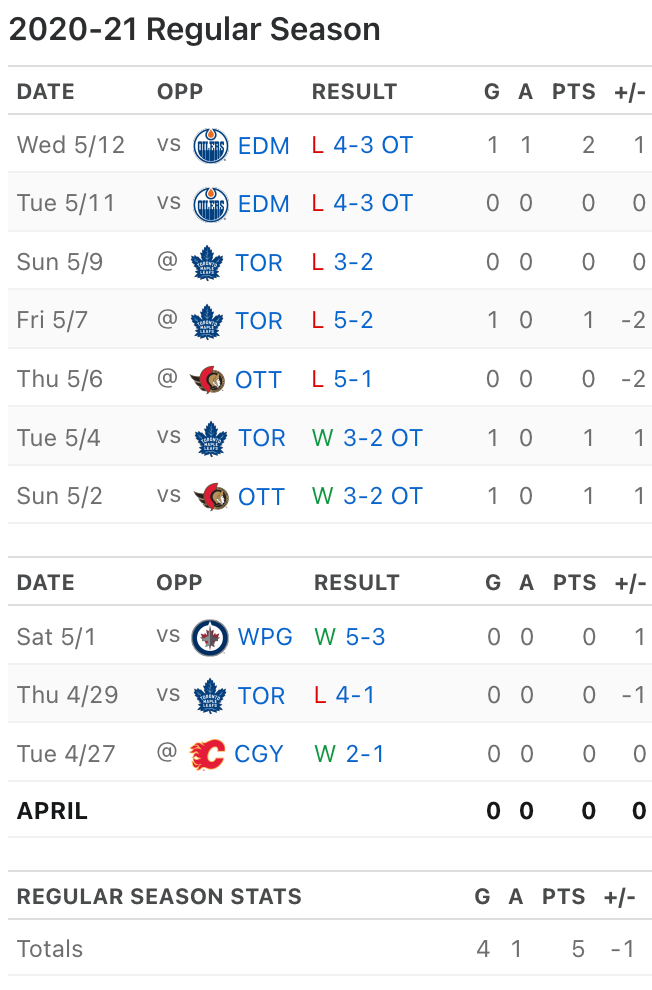There are a few distinct dimensions to consider when it comes to team-building. One of the most exciting and fun topics in the minds of NHL fans and fanatics is the potential of their young prospects to join their NHL team, secure a spot, produce points, earn wins, and carry them to victory.
When Cole Caufield was first called up in the 2020-2021 season it took him just ten games to win the hearts and minds of the Habs faithful. He started slow with 0 points in his first three games and finished with 5 points in his last seven games. Entering the NHL as a 20 year old and attaining a points-per-game (ppg) rate of 0.5 is rather impressive for a fresh rookie who hadn’t played any professional games in his career.
Then, in the playoffs he didn’t play the first two games of the first series against the Maple Leafs but by the third game he was back on the playing roster and never lost his spot again. Playing 20 of 22 games in the run to Stanley Cup Finals — he entered the following 2021-2022 season still considered an NHL rookie while having the special status of having more playoff games than regular season under his belt.
In 2021-2022 both he and the team struggled. Caufield had 1 goal and 7 assists in thirty games under previous head coach Dominique Ducharme and was briefly demoted to the AHL (where he posted 5 points in six games). Prior to the hiring of interim head coach Martin St. Louis, there were murmurs of discontent — that perhaps Caufield was rushed into the NHL, which is something most Habs fans are especially sensitive to considering the drafting and development catastrophes of recent years.
An NHL manager has to weight one element, prospects, and weight it against the other dimensions: the existing roster (every new player displaces another one), the salary cap and wage situation, the coach’s preference/needs, and the perceived contribution of the new player.
In the face of uncertainty, it's better to define the elements and dimensions of a problem before trying to solve it:
Since the coaching change, Cole Caufield has 17 points in 14 games which is a 1.2 PPG and a production pace of 100 points in a 82 game season. If he keeps up a good pace by the end of the season, we can rest easy and be relieved that Caulfield can be penciled in as a top6 NHLer for at least the coming season.
Caufield was given another shot to produce in the NHL and he took it.
So while we are thankful he didn’t need much seasoning in the AHL, we should note he did thrive in the few games he did play there (9 points in eight AHL games). This gave the Habs organization confidence to keep him in the NHL in a top6 role.
The right lesson to take from this case is that not everybody can make the jump as quickly as he did, but he did — a success case. That we shouldn’t be afraid of letting a player take a step back and prove to themselves and club they can produce with a top-line workload in the AHL before they get relied upon to do so in the NHL.
The wrong lesson would be to expect every prospect to slot in and produce… and then if or when they struggle to demote them to lower lines, with inferior linemates, more defensive matchups, and with less TOI. That approach, the Ducharme-Therrien-Bergevin approach, doesn’t give the player the opportunity to thrive and leads to players getting called Bustchenyuk/Galchenybust and Bustaniemi/Kotkaniebust.
When Cole Caufield was first called up in the 2020-2021 season it took him just ten games to win the hearts and minds of the Habs faithful. He started slow with 0 points in his first three games and finished with 5 points in his last seven games. Entering the NHL as a 20 year old and attaining a points-per-game (ppg) rate of 0.5 is rather impressive for a fresh rookie who hadn’t played any professional games in his career.
Then, in the playoffs he didn’t play the first two games of the first series against the Maple Leafs but by the third game he was back on the playing roster and never lost his spot again. Playing 20 of 22 games in the run to Stanley Cup Finals — he entered the following 2021-2022 season still considered an NHL rookie while having the special status of having more playoff games than regular season under his belt.
In 2021-2022 both he and the team struggled. Caufield had 1 goal and 7 assists in thirty games under previous head coach Dominique Ducharme and was briefly demoted to the AHL (where he posted 5 points in six games). Prior to the hiring of interim head coach Martin St. Louis, there were murmurs of discontent — that perhaps Caufield was rushed into the NHL, which is something most Habs fans are especially sensitive to considering the drafting and development catastrophes of recent years.
An NHL manager has to weight one element, prospects, and weight it against the other dimensions: the existing roster (every new player displaces another one), the salary cap and wage situation, the coach’s preference/needs, and the perceived contribution of the new player.
In the face of uncertainty, it's better to define the elements and dimensions of a problem before trying to solve it:
- Very young skill players don’t often thrive (produce) in the NHL unless they’re McDavid-types. It’s rare for a player who doesn’t have any pro-experience or four years in college to jump into the NHL-level game and have a big impact.
- The Habs played Alex Galchenyuk and later Jesperi Kotkaniemi straight out of the draft at a very young age and without much top-flight pro experience between them (Alex had none, Jesperi was an incredibly young rookie in the Finnish league in his draft year). Both players were 3rd overall picks and ultimately disappointed, with their development trajectory flatter than expected.
- Some young skill players struggle over the full 82 game season because they do not have yet the physical stamina to endure that many games at NHL speeds. Sometimes they need even three years to become reliable in that sense.
- The Sophomore Slump. Some young skill players can struggle to heal and prepare for their follow-up season, or they struggle with increased scrutiny and attention from their NHL opponents and coaches.
- There doesn’t seem to be any harm in letting a young skill player (top6 F / top2 D) thrive in the AHL before calling him up to the NHL. By thrive I mean that they produce, or positively tilt the ice in favour of their team, and play against the strongest opponents available with a lot of ice time (TOI).
- Skilled young players (top6/top2 potential) need at least middle6/top4 TOI to produce because bottom-pairing TOI is not conducive to putting up points… and that means…
- Skilled young players would need to displace existing and bonafide NHL players on an NHL roster… and that means…
- A team would benefit by ensuring these skilled young players demonstrate they are capable of producing in a top-line/top-pairing role in the AHL or another equivalent professional league (eg. KHL) so they can be reasonably expected to catch up to the speed and intensity of the NHL and be relied upon on an NHL roster.
- Summary: Don’t rush your skilled young players. If they cannot produce immediately in the NHL, let them demonstrate they can produce in the lower professional leagues first.
Demoting them in terms of NHL-level TOI/linemates is no go - You risk little and gain much more clarity by taking a conservative approach to prospect development.
Since the coaching change, Cole Caufield has 17 points in 14 games which is a 1.2 PPG and a production pace of 100 points in a 82 game season. If he keeps up a good pace by the end of the season, we can rest easy and be relieved that Caulfield can be penciled in as a top6 NHLer for at least the coming season.
Caufield was given another shot to produce in the NHL and he took it.
So while we are thankful he didn’t need much seasoning in the AHL, we should note he did thrive in the few games he did play there (9 points in eight AHL games). This gave the Habs organization confidence to keep him in the NHL in a top6 role.
The right lesson to take from this case is that not everybody can make the jump as quickly as he did, but he did — a success case. That we shouldn’t be afraid of letting a player take a step back and prove to themselves and club they can produce with a top-line workload in the AHL before they get relied upon to do so in the NHL.
The wrong lesson would be to expect every prospect to slot in and produce… and then if or when they struggle to demote them to lower lines, with inferior linemates, more defensive matchups, and with less TOI. That approach, the Ducharme-Therrien-Bergevin approach, doesn’t give the player the opportunity to thrive and leads to players getting called Bustchenyuk/Galchenybust and Bustaniemi/Kotkaniebust.


